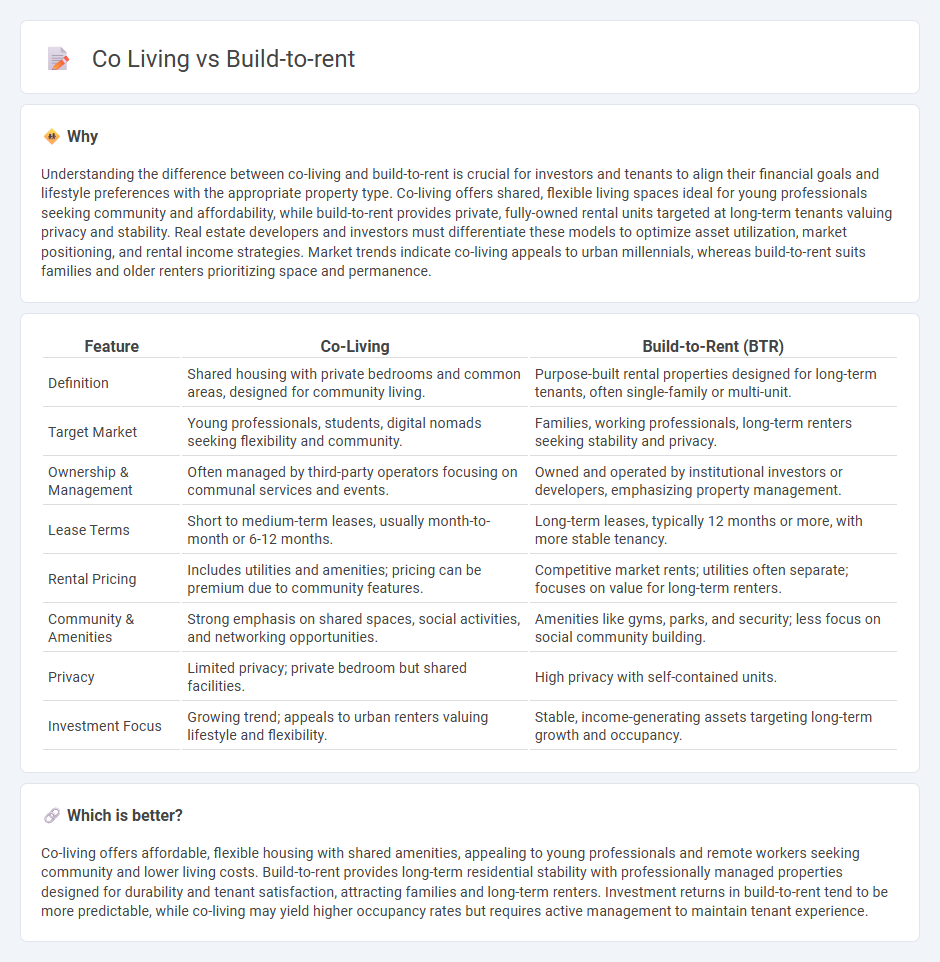
Co-living spaces offer a community-centric living experience with shared amenities and flexible lease terms, appealing to young professionals and urban dwellers seeking affordability and social engagement. Build-to-rent developments provide purpose-built rental properties with private units and long-term stability, targeting families and renters desiring privacy and consistent property management. Explore the differences in investment potential and lifestyle benefits between co-living and build-to-rent models to find the ideal real estate strategy.
Why it is important
Understanding the difference between co-living and build-to-rent is crucial for investors and tenants to align their financial goals and lifestyle preferences with the appropriate property type. Co-living offers shared, flexible living spaces ideal for young professionals seeking community and affordability, while build-to-rent provides private, fully-owned rental units targeted at long-term tenants valuing privacy and stability. Real estate developers and investors must differentiate these models to optimize asset utilization, market positioning, and rental income strategies. Market trends indicate co-living appeals to urban millennials, whereas build-to-rent suits families and older renters prioritizing space and permanence.
Comparison Table
| Feature | Co-Living | Build-to-Rent (BTR) |
|---|---|---|
| Definition | Shared housing with private bedrooms and common areas, designed for community living. | Purpose-built rental properties designed for long-term tenants, often single-family or multi-unit. |
| Target Market | Young professionals, students, digital nomads seeking flexibility and community. | Families, working professionals, long-term renters seeking stability and privacy. |
| Ownership & Management | Often managed by third-party operators focusing on communal services and events. | Owned and operated by institutional investors or developers, emphasizing property management. |
| Lease Terms | Short to medium-term leases, usually month-to-month or 6-12 months. | Long-term leases, typically 12 months or more, with more stable tenancy. |
| Rental Pricing | Includes utilities and amenities; pricing can be premium due to community features. | Competitive market rents; utilities often separate; focuses on value for long-term renters. |
| Community & Amenities | Strong emphasis on shared spaces, social activities, and networking opportunities. | Amenities like gyms, parks, and security; less focus on social community building. |
| Privacy | Limited privacy; private bedroom but shared facilities. | High privacy with self-contained units. |
| Investment Focus | Growing trend; appeals to urban renters valuing lifestyle and flexibility. | Stable, income-generating assets targeting long-term growth and occupancy. |
Which is better?
Co-living offers affordable, flexible housing with shared amenities, appealing to young professionals and remote workers seeking community and lower living costs. Build-to-rent provides long-term residential stability with professionally managed properties designed for durability and tenant satisfaction, attracting families and long-term renters. Investment returns in build-to-rent tend to be more predictable, while co-living may yield higher occupancy rates but requires active management to maintain tenant experience.
Connection
Co-living and build-to-rent models both address the growing demand for flexible, affordable housing solutions in urban areas by combining shared living spaces with professionally managed rental properties. Build-to-rent developments often incorporate co-living designs to maximize space efficiency and foster community among residents, appealing to young professionals and transient populations. This synergy enhances rental yields and provides scalable housing options tailored to lifestyle preferences and economic trends in real estate markets.
Key Terms
Ownership Structure
Build-to-rent developments are typically owned by institutional investors or real estate investment trusts (REITs), providing long-term, professionally managed rental properties under a single ownership. Co-living spaces often involve multiple stakeholders, such as property owners, management companies, and sometimes shared ownership models among residents, emphasizing communal living and flexible lease terms. Explore detailed comparisons to understand how ownership impacts tenant experience and investment potential.
Lease Agreements
Build-to-rent properties typically offer longer lease agreements, often 12 months or more, providing tenants with stability and predictable rental costs. Co-living spaces usually feature shorter, more flexible lease terms ranging from one month to six months, catering to transient residents and promoting community living. Explore the key differences in lease agreements to determine which housing solution aligns best with your lifestyle needs.
Amenities
Build-to-rent properties often feature private amenities like in-unit washers, fitness centers, and dedicated parking, designed for long-term tenant convenience and privacy. Co-living spaces emphasize shared amenities such as communal kitchens, lounges, and coworking areas to foster social interaction and community living. Explore the distinct amenities shaping your ideal rental lifestyle and learn more about which option suits your needs.
Source and External Links
Build to rent - Wikipedia - Build-to-rent (BTR) refers to residential properties that are purpose-built, institutionally owned, and professionally managed for rental on the open market rather than sold, with growth mainly in UK cities and innovations focused on sustainability and modern technology.
What Is Build-to-Rent? | An Introductory Guide - Gatsby Investment - BTR properties are designed specifically for long-term renters, catering to increased rental demand driven by affordability and lifestyle preferences, and include a variety of residential types offering benefits for renters and investors.
A.CRE Build-to-Rent (BTR) Development Model - Build-to-rent communities are planned neighborhoods of single-family or attached homes owned and managed by a single entity, offering renters amenities and professional management, combining the appeal of single-family living with rental flexibility and investment stability.
 dowidth.com
dowidth.com